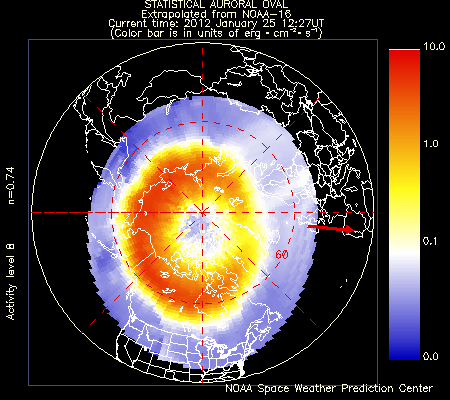Antti Pietikäinen submitted this photo to Spaceweather.com yesterday. Said Pietikäinen: "We went out with snowmobiles to wait for the incoming storm in Muonio, West-Lapland, Finland."
Yesterday, a coronal mass ejection (CME) hit the Earth’s magnetic field at around 10am EST. The result? A G1-class geomagnetic storm that produced bright auroras around the Arctic Circle, and flight carriers such as Delta that had to re-route their flight paths around the North Pole as a precautionary measure.
The NOAA/Space Weather Prediction Center in the US said the solar radiation storm was the largest one since October 2003. It classified it as an S3 storm, with S5 being the highest classified storm you can get.
Delta Airlines yesterday re-routed some of its planes travelling in the transpolar region between Asia and the US, flying them further south than normal. The carrier American Airlines said it was monitoring the atmosphere but it had not diverted any flights due to the solar flare.
However, stargazers in Scandinavia, Iceland and Greenland were treated to auroras, similar to the Northern Lights, or aurora borealis. The auroras (aurorae) sprang from the geomagnetic storm. As it traversed over the Atlantic, the solar storm had petered out before it reached North America, according to Spaceweather.com.

Latest Northern Statistical Auroral Oval. Image courtesy of NOAA Space Weather Prediction Center
Solar maximum
So what’s been happening with the sun to cause such solar turmoil? Solar activity amplifies every 11 years and the sun is entering the peak of this cycle, also known as a solar maximum. The National Oceanic and Atmospheric Administration (NOAA) is predicting that the solar maximum is expected in May 2013.
Such solar activity triggers solar flares that then hurl their radiation towards Earth. This radiation is not thought to be harmful to humankind. However, it can pose a threat to astronauts in space, plus it can also affect telecommunications, power grids, radio signals and GPS systems. That is why telcos and utilities are keeping a close eye on the sun’s activity this year.
What exactly are solar flares? NASA describes them as “giant explosions” on the sun that send energy, light and high-speed particles into space. Such flares are often linked with solar magnetic storms, otherwise known as coronal mass ejections – think of the CME that has been triggered this week, which has produced the aurora displays. And as well as CMEs, the sun can also emit streams of very fast protons and disturbances in the solar wind.
“All of these can produce a variety of ‘storms’ on Earth that can – if strong enough – interfere with short-wave radio communications, GPS signals, and Earth’s power grid, among other things,” explains NASA.
NOAA has classified five solar flares based on their strength:
- The biggest flares are known as X-class flares, while the smallest ones are classified as A-class flares.
- The other categories are B, C and M flares. C-class and smaller flares are thought to be too weak to affect the planet.
- M-class flares can cause brief radio blackouts at the poles and minor radiation storms that could pose dangers to astronauts.
In terms of space weather, the NOAA Space Weather Prediction Center expects solar activity to be low between 25-27 January. It indicated there would be some after effects of the arrival of the CME on 23 January, with isolated major storm intervals.
“The geomagnetic field is expected to be at unsettled to minor storm levels, with isolated major storm intervals, on day one (today), says NOAA.